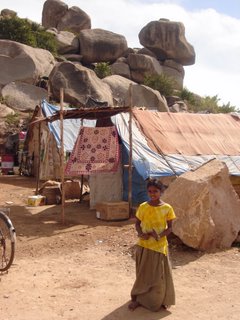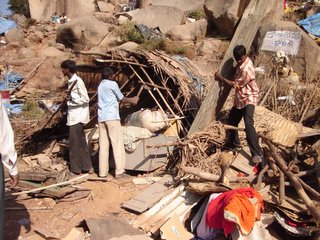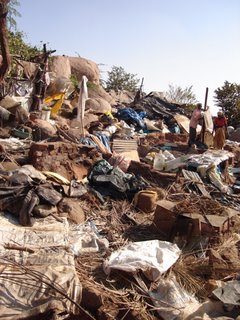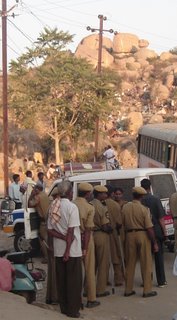 The second big problem these last few weeks happened on "the hillside." Twenty of my students live in huts set up and across a hill near the main part of the neighborhood. This is the "worst" area; it has no electricity or water supplies. But that hillside is my favorite part of the neighborhood. I have my mental map of who lives where: the young couple with the new baby are near the top right, the tailor and his grandchildren (who go to the school) are near the bottom center, and the recalcitrant grandmother who hides when I want to take her picture is on the bottom left. The father pictured in the last entry, along with his family, are on the far side of the hill, towards the center. Here is a picture of some of the huts around mid-December (on the left).
The second big problem these last few weeks happened on "the hillside." Twenty of my students live in huts set up and across a hill near the main part of the neighborhood. This is the "worst" area; it has no electricity or water supplies. But that hillside is my favorite part of the neighborhood. I have my mental map of who lives where: the young couple with the new baby are near the top right, the tailor and his grandchildren (who go to the school) are near the bottom center, and the recalcitrant grandmother who hides when I want to take her picture is on the bottom left. The father pictured in the last entry, along with his family, are on the far side of the hill, towards the center. Here is a picture of some of the huts around mid-December (on the left).Government police and laborers tore away the huts on December 29. By January 14, many were rebuilt. I’m saying that right now so there isn't undue worrying.

Here is a picture of the action. That morning, I walked up toward school and saw the brown shirts (police) standing around. The people who live in these huts are unbelievably nice, so nice. They would never hurt anyone and would give you the shirt off their backs. To see squads of police was just funny. No way is there trouble here. I was curious, what was up?
Then I saw the government crews wrecking the huts. I burst into tears. Uncontrollably, but quietly, I started crying.
The little boy and two little girls who live at the bottom of the hill saw me crying. They are real little, four or five years old. They ran to me, pulled at my hands and talked to me, then they ran to the sandpile next to the new construction across the street and started digging. I wasn’t paying much attention, I thought they were playing and all done with me. I was surprised when they ran back and found me again. The little ones pulled me down to say something, then dropped a dozen periwinkle shells into my hands. They were digging for the little shells that all sand in India seems to have. (It must come from a real beach.) Their homes were gone, but they found me a gift to help me feel better.
 It took all morning to tear the huts down. The government laborers used axes to hack into the bindings holding the long wood roof and wall poles togeather. All the contents of the huts were pitched out onto the surrounding hillside. Household things like cooking pots, bedding, childrens’ clothes, and plastic water jugs were everywhere. The concrete floors were busted up with sledgehammers. The whole area sounded like trees falling over in a storm, loud cracking sounds and thuds.
It took all morning to tear the huts down. The government laborers used axes to hack into the bindings holding the long wood roof and wall poles togeather. All the contents of the huts were pitched out onto the surrounding hillside. Household things like cooking pots, bedding, childrens’ clothes, and plastic water jugs were everywhere. The concrete floors were busted up with sledgehammers. The whole area sounded like trees falling over in a storm, loud cracking sounds and thuds.The salvageable bits were carted away. The government crews loaded up all the longer pieces of wood, neatly stacked, into one truck. Metal, plastic, and smaller bits of wood were loaded into different trucks.
A pause here to say India is still largely a black market economy. Eighty percent or so of businesses are off the books. A clever, weasel-like government official figured ripping off the poor people of their reusable materials could make him a few bucks.
None of the people who lived on the hillside were upset, certainly not cryin
 g! I found this odd. It seems this happens every six months or so, they seem to accept it. Still, I was so angry. I started taking pictures. That got the head honcho government guy very nervous and he started to walk away, so I started to take a movie. Of him. Running away. The police were obviously embarrassed to be on this duty and stayed close to each other or in the white police bus that brought them to the site.
g! I found this odd. It seems this happens every six months or so, they seem to accept it. Still, I was so angry. I started taking pictures. That got the head honcho government guy very nervous and he started to walk away, so I started to take a movie. Of him. Running away. The police were obviously embarrassed to be on this duty and stayed close to each other or in the white police bus that brought them to the site.I stopped taking pictures and started to check on the students. Ismail and I went up and down until we found them all. We reassured them that they could come back and go to school again anytime. I took more pictures. I don't know what happened that night, or where they slept or if they ate. The next day, they started to rebuild.
On Monday, we had a few of those students back at school. I hope that we’ll see almost all our students from those huts again. Below is a picture of the family with the father from the last entry in their new hut. They are back in the same spot, on the far side of the hill near the center.
 Here is one of the students from this hillside. It was taken on Monday. In this picture I'm holding her on my hip, even though she is far too big, because she jumped into my arms for a long hug. She is a very good student. Knowing all that she has been through, I am powerfully motivated to make sure her school is worthy of her.
Here is one of the students from this hillside. It was taken on Monday. In this picture I'm holding her on my hip, even though she is far too big, because she jumped into my arms for a long hug. She is a very good student. Knowing all that she has been through, I am powerfully motivated to make sure her school is worthy of her.
Comments
Post a Comment
Leave a Message